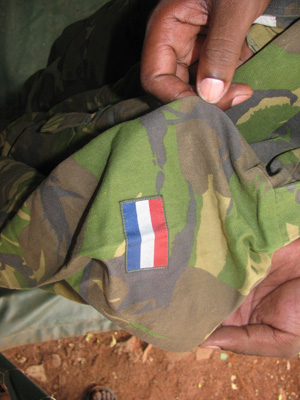OBO, Central African Republic – On March 8, 2010, a Ugandan army commander said his troops had just attacked a group from the Lord’s Resistance Army a day before. Not far from the border with the Democratic Republic of the Congo, the attack had killed a few LRA rebels, one of whom Ugandan soldiers believed was Opiyo Sam, a senior LRA commander. A military intelligence officer said identification was impossible as the dead person’s face was shattered.

What was found in the possessions of the dead LRA fighter was interesting. A rusty Chinese AK-47, a small notebook—which I was not allowed to see—and two new military uniforms. One was a typical khaki camouflage uniform used by military and hunters alike. The other uniform bore the flag of Luxembourg (see pictured). It is puzzling how a Luxembourg uniform ended up in LRA hands. One soldier claimed it could have come from the park rangers in the Congolese Garamba National Park although I can’t explain how the uniform ended up in Garamba in the first place.
It is common knowledge that LRA fighters use whatever uniforms they can put their hands on. Once I interviewed a former LRA still wearing a uniform of the Congolese national army. At least 18 Congolese army uniforms were stolen last December in the Congolese town of Bangadi. There have also been reports of LRA donning stolen uniforms from the South Sudan army, or SPLA. Witnesses to attacks have said that the LRA uses Ugandan army uniforms, although at times Congolese and Central African civilians are confused by the Ugandan flag which the LRA also use on their uniforms.
Joseph Kony gave interviews in 2007 wearing what appeared to be a U.N. peacekeeper blue beret. It is almost certain the beret belonged to a contingent of U.N. Guatemalan elite forces, the Kaibils, who lost eight soldiers in a battle with the LRA in January 2006. Last June, the Ugandan army claimed it had recovered uniforms and guns from the LRA belonging to the deceased Guatemalans, including an Israeli made Galil 5.56 assault rifle, a weapon commonly used by the Kaibils until recently replaced by the lighter M16.
The use of different uniforms is a necessity for the LRA, a group that is not as supplied as a regular army. Most importantly, the mix of uniforms is strategically used to confuse local populations the LRA targets. LRA troops in DRC have pretended to be Ugandan army soldiers in order to capture (and eventually kill) as many civilians as possible in the past. In March 2009, in order to preserve the element of surprise when attacking Mboki in Central African Republic, LRA fighters walked to the main market saying they were Ugandan soldiers.
There are, however, indications that the LRA is running out of uniforms. Congolese witnesses of LRA attacks, now refugees in CAR, said that LRA fighters were recently not only looting food and other property, but were also stealing peoples’ clothes. “They made us take all of our clothes off,” said a woman. “[The LRA] left us completely naked and the men in their underwear.”
These anecdotes suggest that the LRA might have failed to secure uniforms and supplies from external sources. One particular detail from the stories, however, is worrying. On recent looting expeditions, LRA fighters kept looking for children’s clothing, a disturbing reminder of the large numbers of young boys and girls abducted by the LRA. “They need clothes for the children,” said a former abductee in CAR. “Because the young are getting sick in the cold nights here.”

